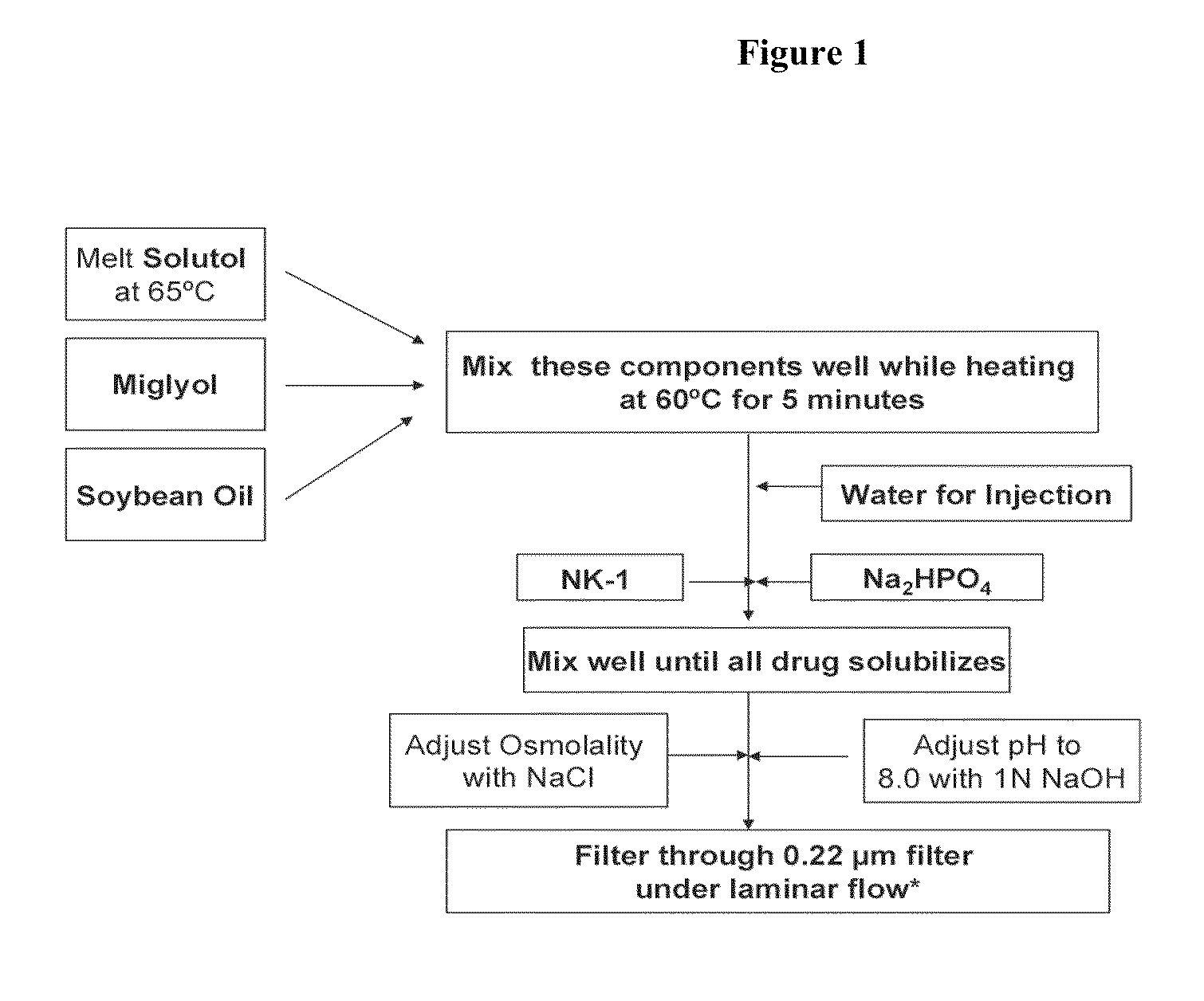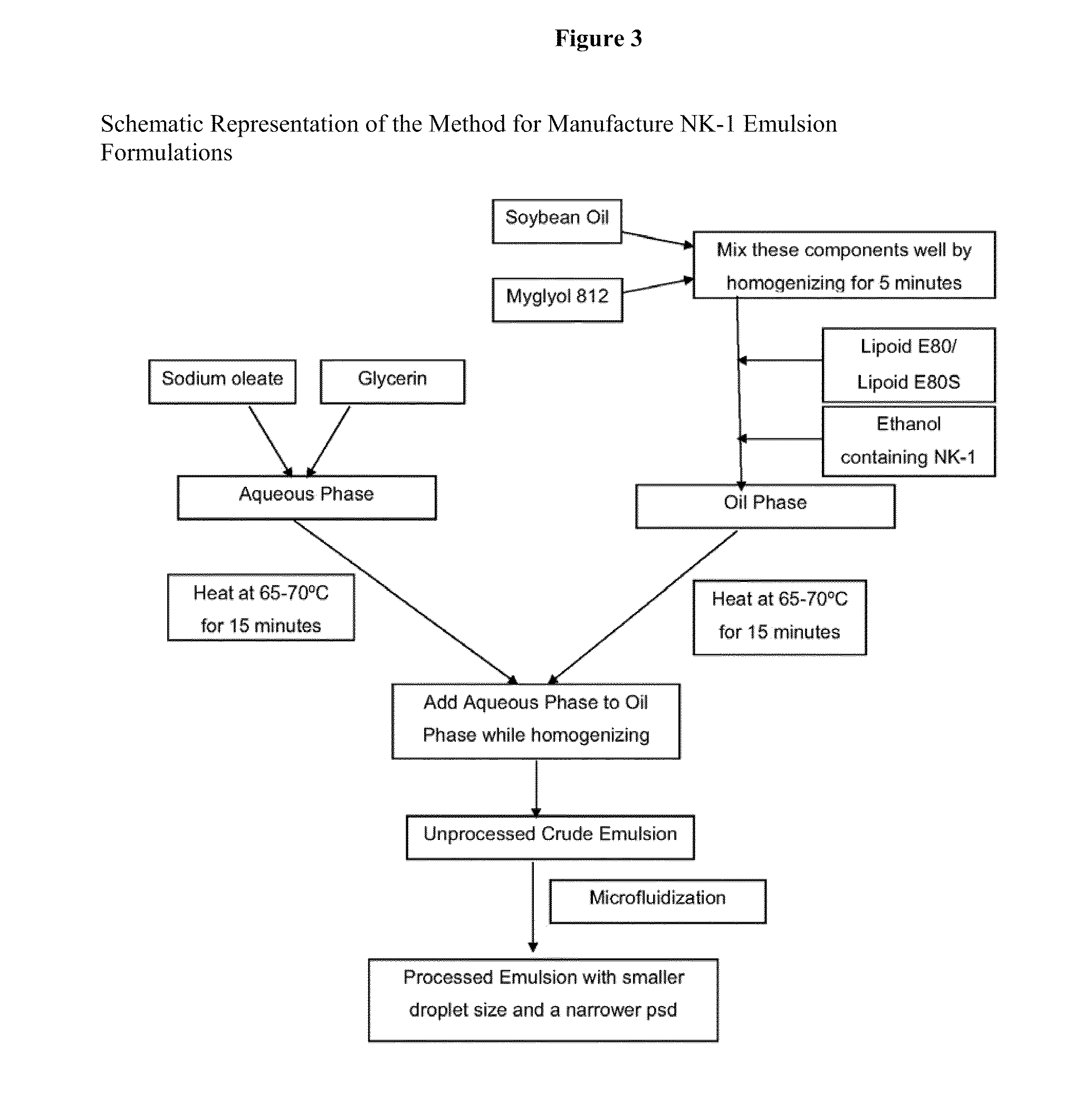Intravenous formulations of neurokinin-1 antagonists
- Summary
- Abstract
- Description
- Claims
- Application Information
AI Technical Summary
Benefits of technology
Problems solved by technology
Method used
Image
Examples
example 1
Evaluation of Solubility of Compound 1 in Cyclodextrin-Based and Other Co-Solvent Systems
[0221]The solubility of Compound 1 in 16% Captisol® (a sulfobutyl ether derivative of 3-cyclodextrin, available from Cydex Inc. of Overland Park, Kans.) and a co-solvent system propylene glycol:ethanol (PG:EtOH, 40%:10%) was evaluated by determining the equilibrium solubility of Compound 1 in these solvent systems. Compound 1 concentration was assayed by the High Performance Liquid Chromatography (HPLC) method as described in Example 5 at difference time points for the determination of equilibrium solubility, which was attained once the solubility reached a plateau (does not change appreciably) over time. Optimal solubility of Compound 1 was found with 16% Captisol (data not shown).
example 2
Studies in Rats Intravenously Administered NK-1 Formulations Containing Captisol® and Other Co-Solvent Systems
[0222]16% Captisol® and the co-solvent system PG:EtOH 40%:10% were intravenously administered to rats.
[0223]Urine samples from the rats were assessed for hemolysis using Hemastix® reagent strips (No. 2190, Bayer Corp., Elkhart Ind.). The presence of blood in urine was detected using Hemastix® reagent strips (No. 2190, Bayer Corp., Elkhart Ind.). The Hemastix® reagent strips detect the peroxide-like activity of hemoglobin. The strips turn from yellow to dark green depending upon the amount of hemoglobin found in the urine. The Hemastix® scale is as follows: 0=negative, 1=non-hemolyzed trace, 3=hemolyzed trace, 4=small+, 5=moderate++, and 6=large+++.
[0224]Though the cyclodextrin and the co-solvent formulations succeeded in improving solubility of Compound 1, the co-solvent formulations unexpectedly lead to severe hemolysis (on a scale of 6 on the Hemastix® scale) on intravenou...
example 3
Studies Evaluating the Occurrence of Hemolysis in Rats Upon Bolus Administration of Formulation Containing 22% Solutol
[0226]Studies were then performed in male and female rats with the aim of reducing the local high concentration of free Compound 1 by 1) incorporating Compound 1 to the hydrophobic core of micelles utilizing Solutol® HS15 (macrogol 15-hydroxystearate, also referred herein as Solutol), 2) injecting via the bolus route Compound 1 incorporated in Solutol and 2) testing for the occurrence of hemolysis (using the Hemastix® reagent strips) at various time intervals (15-60 minutes).
[0227]The results indicated that in both male and female rats the occurrence of hemolysis reduced significantly with time (Table 2), and led to the conclusion that local high free concentration of Compound 1 was responsible for the transient hemolysis which occurred within the first few minutes after intravenous dosing.
TABLE 2Transient Nature of Hemolysis Caused byCompound 1 on Intravenous Admini...
PUM
| Property | Measurement | Unit |
|---|---|---|
| Temperature | aaaaa | aaaaa |
| Temperature | aaaaa | aaaaa |
| Fraction | aaaaa | aaaaa |
Abstract
Description
Claims
Application Information
 Login to View More
Login to View More - R&D
- Intellectual Property
- Life Sciences
- Materials
- Tech Scout
- Unparalleled Data Quality
- Higher Quality Content
- 60% Fewer Hallucinations
Browse by: Latest US Patents, China's latest patents, Technical Efficacy Thesaurus, Application Domain, Technology Topic, Popular Technical Reports.
© 2025 PatSnap. All rights reserved.Legal|Privacy policy|Modern Slavery Act Transparency Statement|Sitemap|About US| Contact US: help@patsnap.com



